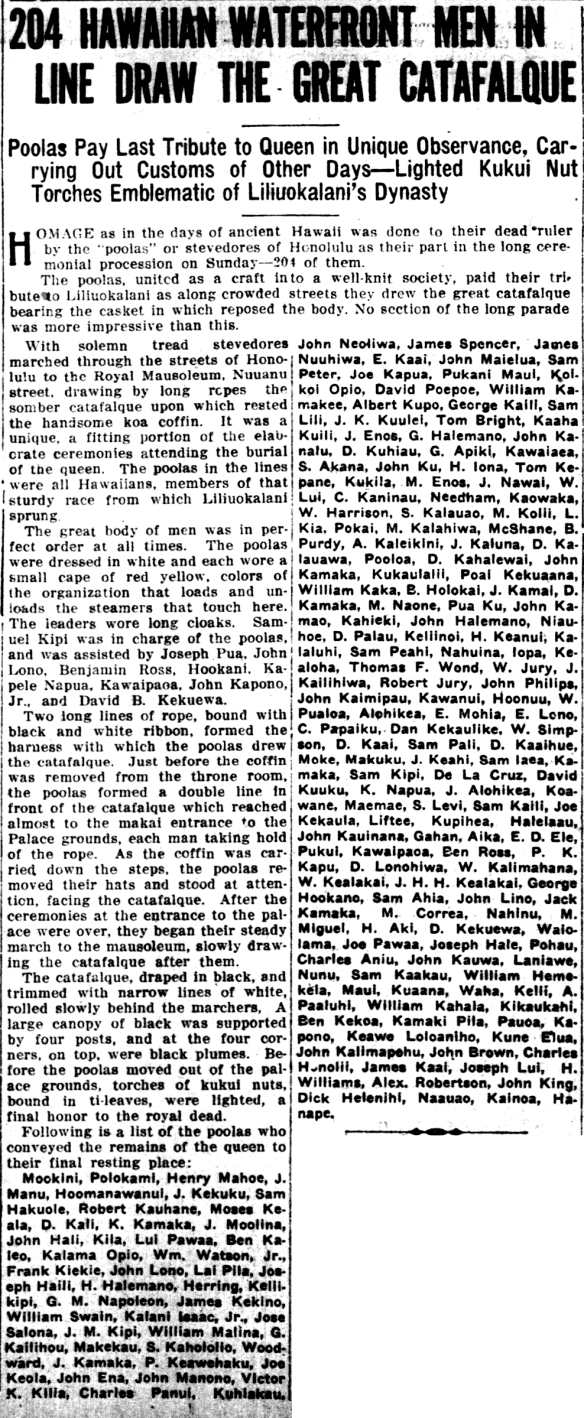This is an independent blog. Please note that these are not translations, but merely works in progress. Please do comment if you come across misreads or anything else you think is important!

Names of the stevedores who participate in Queen Liliuokalani’s funeral, 1917.
204 HAWAIIAN WATERFRONT MEN IN LINE DRAW THE GREAT CATAFALQUE
Poolas Pay Last Tribute to Queen in Unique Observance, Carrying Out Customs of Other Days—Lighted Kukui Nut Torches Emblematic of Liliuokalani’s Dynasty
HOMAGE as in the days of ancient Hawaii was done to their dead ruler by the “poolas” or stevedores of Honolulu as their part in the long ceremonial procession on Sunday—204 of them.
The poolas, untied as a craft into a well-knit society, paid their tribute to Liliuokalani as along crowded streets they drew the great catafalque bearing the casket in which reposed the body. No section of the long parade was more impressive than this.
With solemn tread stevedores marched through the streets of Honolulu to the Royal Mausoleum, Nuuanu street, drawing by long ropes the somber catafalque upon which rested the handsome koa coffin. It was a unique, fitting portion of the elaborate ceremonies attending the burial of the queen. The poolas in the lines were all Hawaiians, members of that sturdy race from which Liliuokalani sprung.
The great body of men was in perfect order at all times. The poolas were dressed in white and each wore a small cape of red yellow, colors of the organization that loads and unloads the steamers that touch here. The leaders wore long cloaks. Samuel Kipi was in charge of the poolas, and was assisted by Joseph Pua, John Lono, Benjamin Ross, Hookani, Kapele Napua, Kawaipaoa, John Kapono, Jr., and David B. Kekuewa.
Two long lines of ropes, bound with black and white ribbon, formed the harness with which the poolas drew the catafalque. Just before the coffin was removed from the throne room, the poolas formed a double line in front of the catafalque which reached almost to the makai entrance to the Palace grounds, each man taking hold of the rope. as the coffin was carried down the steps, the poolas removed their hats and stood at attention, facing the catafalque. After the ceremonies at the entrance to the palace were over, they began their steady march to the mausoleum, slowly drawing the catafalque after them.
The catafalque, draped in black, and trimmed with narrow lines of white, rolled slowly behind the marchers. A large canopy of black was supported by four posts, and at the four corners, on top, were black plumes. Before the poolas moved out of the palace grounds, torches of kukui nuts, bound in ti-leaves, were lighted, a final honor to the royal dead.
Following is a list of the poolas who conveyed the remains of the queen to their final resting place:
Mookini, Polokami, Henry Mahoe, J. Manu, Hoomanawanui, J. Kekuku, Sam Hakuole, Robert Kauhane, Moses Keala, D. Kali, K. Kamaka, J. Moolina, John Hali, Kila, Lui Pawaa, Ben Kaleo, Kalama Opio, William Watson, Jr., Frank Kiekie, John Lono, Lai Pila, Joseph Haili, H. Halemano, Herring, Keliikipi, G. M. Napoleon, James Kekino, William Swain, Kalani Isaac, Jr., Jose Salona, J. M. Kipi, William Malina, G. Kailihou, Makekau, S. Kahololio, Woodward, J. Kamaka, P. Keawehaku, Joe Keola, John Ena, John Manono, Victor K. Kilia, Charles Panui, Kuhiakau, John Neoliwa, James Spencer, James Nuuhiwa, E. Kaai, John Maielua, Sam Peter, Joe Kapua, Pukani Maui, Koikoi Opio, David Poepoe, William Kamakee, Albert Kupo, George Kaili, Sam Lili, J. K. Kuulei, Tom Bright, Kaaha Kuili, J. Enos, G. Halemano, John Kanalu, D. Kuhiau, G. Apiki, Kawaiaea, S. Akana, John Ku, H. Iona, Tom Kepane, Kukila, M. Enos, J. Nawai, W. Lui, C. Kaninau, Needham, Kaowaka, W. Harrison, S. Kalauao, M. Koili, L. Kia, Pokai, M. Kalahiwa, McShane, B. Purdy, A. Kaleikini, J. Kaluna, D. Kalauawa, Pooloa, D. Kahalewai, John Kamaka, Kukaulaili, Poai Kekuaana, William Kaka, B. Holokai, J. Kamai, D. Kamaka, M. Naone, Pua Ku, John Kamao, Kahieki, John Halemano, Niauhoe, D. Palau, Keliinoi, H. Keanui, Kalaluhi, Sam Peahi, Nahuina, Iopa, Kealoha, Thomas F. Wond, W. Jury, J. Kailihiwa, Robert Jury, John Philips, John Kaimipau, Kawanui, Hoonuu, W. Pualoa, Alohikea, E. Mohia, E. Lono, C. Papaiku, Dan Kekaulike, W. Simpson, D. Kaai, Sam Pali, D. Kaaihue, Moke, Makuku, J. Keahi, Sam Iaea, Kamaka, Sam Kipi, De La Cruz, David Kuuku, K. Napua, J. Alohikea, Koawane, Maemae, S. Levi, Sam Kaili, Joe Kekaula, Liftee, Kupihea, Halelaau, John Kauinana, Kahan, Aika, E. D. Ele, Pukui, Kawaipaoa, Ben Ross, P. K. Kapu, D. Lonohiwa, W. Kalimahana, W. Kealakai, J. H. H. Kealakai, George Hookano, Sam Ahia, John Lino, Jack Kamaka, M. Correa, Nahinu, M. Miguel, H. Aki, D. Kekuewa, Waiolama, Joe Pawaa, Joseph Hale, Pohau, Charles Aniu, John Kauwa, Laniawe, Nunu, Sam Kaakau, William Hemekela, Maui, Kuaana, Waha, Kelli, A. Paaluhi, William Kahala, Kikaukahi, Ben Kekoa, Kamaki Pila, Pauoa, Kapono, Keawe Loloaniho, Kune Elua, John Kalimapehu, John Brown, Charles Honolii, James Kaai, Joseph Lui, H. Williams, Alex. Robertson, John King, Dick Helenihi, Naauao, Kainoa, Hanape.
(Honolulu Star-Bulletin, 11/19/1917, p. 7)


No comments:
Post a Comment